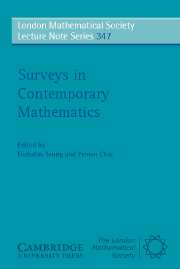Book contents
- Frontmatter
- Contents
- Preface
- Rank and determinant functions for matrices over semirings
- Algebraic geometry over Lie algebras
- Destabilization of closed braids
- n-dimensional local fields and adeles on n-dimensional schemes
- Cohomology of face rings, and torus actions
- Three lectures on the Borsuk partition problem
- Embedding and knotting of manifolds in Euclidean spaces
- On Maxwellian and Boltzmann distributions
Cohomology of face rings, and torus actions
Published online by Cambridge University Press: 16 March 2010
- Frontmatter
- Contents
- Preface
- Rank and determinant functions for matrices over semirings
- Algebraic geometry over Lie algebras
- Destabilization of closed braids
- n-dimensional local fields and adeles on n-dimensional schemes
- Cohomology of face rings, and torus actions
- Three lectures on the Borsuk partition problem
- Embedding and knotting of manifolds in Euclidean spaces
- On Maxwellian and Boltzmann distributions
Summary
Introduction
This article centres on the cohomological aspects of ‘toric topology’, a new and actively developing field on the borders of equivariant topology, combinatorial geometry and commutative algebra. The algebrogeometric counterpart of toric topology, known as ‘toric geometry’ or algebraic geometry of toric varieties, is now a well established field in algebraic geometry which is characterized by strong links with combinatorial and convex geometry (see the classical survey paper or the more modern exposition). Since the appearance of Davis and Januszkiewicz's work, where the concept of a (quasi)toric manifold was introduced as a topological generalization of a smooth compact toric variety, there has grown an understanding that most phenomena of smooth toric geometry may be modelled in the purely topological situation of smooth manifolds with a nicely behaved torus action.
One of the main results of is that the equivariant cohomology of a toric manifold can be identified with the face ring of the quotient simple polytope; or, for more general classes of torus actions, with the face ring of a certain simplicial complex K. The ordinary cohomology of a quasitoric manifold can also be effectively identified as the quotient of the face ring by a regular sequence of degree-two elements, which provides a generalization of the well-known Danilov-Jurkiewicz theorem of toric geometry. The notion of the face ring of a simplicial complex sits at the heart of Stanley's ‘combinatorial commutative algebra’, linking geometrical and combinatorial problems concerning simplicial complexes with commutative and homological algebra.
- Type
- Chapter
- Information
- Surveys in Contemporary Mathematics , pp. 165 - 201Publisher: Cambridge University PressPrint publication year: 2007
- 4
- Cited by



